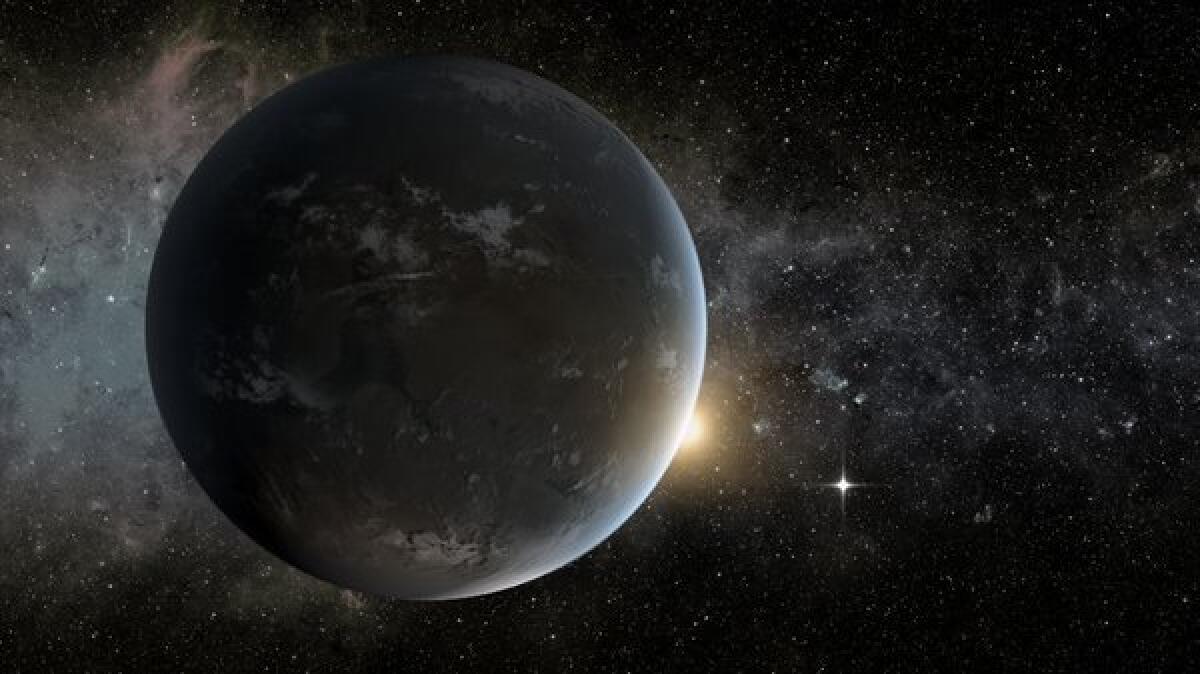Planet-hunting Kepler reveals secret code hidden in starlight

- Share via
Using data from the planet-hunting Kepler space telescope, astronomers have discovered a telltale “flicker” pattern in a distant star’s light -- an interstellar Morse code that reveals hidden but crucial information about its mass and volume.
Their quick scientific trick, described last week in the journal Nature, could improve estimates of stars’ sizes by three times or more -- and thus, improve estimates of exoplanets’ sizes as well.
Pinning down stellar sizes using starlight is surprisingly difficult. Estimates of a star’s surface gravity -- a measure that can help reveal both a star’s mass and its radius -- can by off by as much as 90%.
Stellar seismology can get more accurate readings on a star’s surface gravity essentially by tracking the sounds it makes – but that process is much harder and takes a lot longer.
That’s a problem, because our understanding of stars -- including their ages -- is linked to their mass and volume. A small, dense dwarf star is usually younger; red giants, which can be a hundred times larger but much less dense, are much further along in life.
A star’s size also affects how its companion planets are sized up. Kepler finds exoplanets by watching for dips in light as planets pass in front of their stars and cast a little shadow. But that dip in light is measured relative to the star’s size. So if scientists think the star is smaller than it actually is, the planet will look smaller than it really is too.
This can have major implications, given the hunt for increasingly Earth-like planets, said lead author Fabienne Bastien, an astronomer at Vanderbilt University in Nashville.
“You want to make sure the planet you think is like Earth is really like Earth,” she said.
Ancient Egyptians forged jewelry beads with meteorites from space
Bastien, a graduate student, said she didn’t go looking to solve this problem.
“We were seeing some weird results in my dissertation work,” Bastien said, “and in trying to understand these results, we fell upon the flicker method.”
To figure out why her own data didn’t make sense, she used an answer key of sorts: already-published stellar seismology data for some of the stars she was studying. Perhaps she could use this data to pick out a pattern in her own.
The researchers began to notice that the pattern of brightening and dimming changed depending on the size of the star. The small dwarf stars flickered faster, over a period of minutes, but not dramatically. The giant stars flickered at a much slower rate, over a few hours, but with much higher contrast.
Once they filtered the data for variations caused by sunspots and other longer-range fluctuations in starlight -- anything above eight hours, Bastien said -- this short-term pattern was striking.
The fluctuations in light came from the tiny variations across the star’s boiling surface of plasma, called granulation, Bastien explained. This boiling pattern depends on the star’s size: Imagine a tiny saucepan with a little bit of fast-bubbling water and a large, witchy cauldron with large, slow, heavily popping bubbles.
“If you have something that’s boiling very rapidly and with a very small boiling pattern, that tells you it’s a dwarf,” Bastien said. “If it’s very big and slow, then it’s a giant.”
This new method improves the accuracy by about three times, the scientists said -- and it does it very quickly. The effect can be observed over a period of minutes to hours (depending on the size of the star) -- and the calculation takes mere moments.
“You can get a measurement for a single star in a few seconds,” Bastien said. “Measuring flicker is actually very easy. It just requires a few lines of code to get the basic result.”
It’s unclear whether the researchers would be able to continue using the hobbled Kepler telescope to gather even more “flicker” data, Bastien said.
In any case, the method “holds great promise for measuring stellar properties and understanding the complex dynamics of the outermost layers of stars,” Jørgen Christensen-Dalsgaard, an astroseismologist at Aarhus University who was not involved in the study, wrote in a commentary.
The new method of accurately calculating a star’s mass and radius in a matter of minutes could come in handy for NASA’s Transiting Exoplanet Survey Satellite, Christensen-Dalsgaard said. TESS, set for launch in 2017, will use the same method as Kepler to search the entire sky for alien planets -- not just a celestial patch of 150,000 stars, as Kepler has.
ALSO:
A hunt for dark matter in a former gold mine
Eureka! Did crashing neutron stars forge all gold in Universe?
50 shades of window? ‘Smart glass’ blocks heat, light at flip of switch




